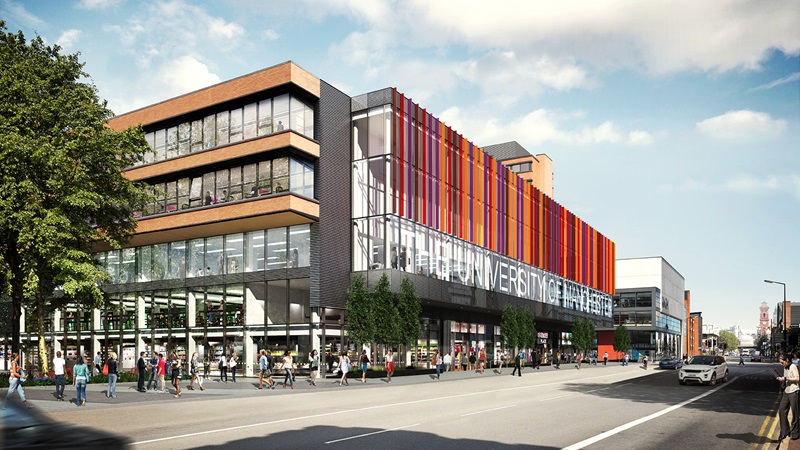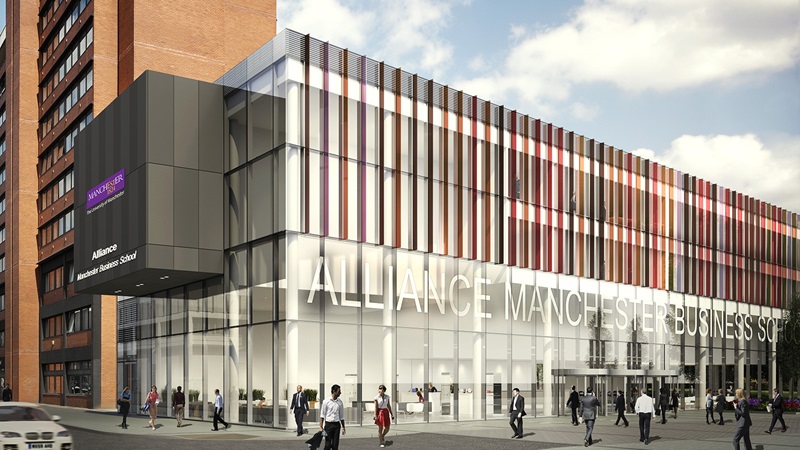Mace tackles core of the problem in Manchester
Modernising the University of Manchester’s business school has been much more than a simple refurbishment job for Mace.
Anyone familiar with the Oxford Road corridor in Manchester, which has the distinction of being Europe’s busiest bus route, will know that it hasn’t always been blessed with the most attractive of buildings.
Perhaps one of the worst offenders was the Alliance Manchester Business School, a 1960s concrete behemoth complete with a covered shopping precinct and a bridge over Oxford Road – hardly a bright and airy gateway to either the city centre or the university.
But with the university’s modernisation of its campus and regeneration of the surrounding area, clients Bruntwood and University of Manchester have seized the opportunity to overhaul the area into a modern hub for both education and retail.
Mace has taken on the job of what has been described as a refurbishment – but with it has come many more challenges, including major demolition works, road closures, extensive M&E planning and asbestos removal.
Turn of the 21st century
The Alliance Manchester Business School sits on the corner of Oxford Road and Booth Street, on the cusp of the city centre. The busy crossroads is also host to both the Royal Northern College of Music and the Manchester Aquatics Centre, making it a hotspot for education and sports.
However, the Business School building has long been in need of a refurbishment to bring it into the 21st century.
Mace was appointed to the scheme in July 2015, after the client initially worked with Vinci to remove the bridge over Oxford Road. Mace took over the project with a design already in place, but project director Ian Goddard says the team was essentially “starting from scratch”.
He explains that the original project was divided into two phases, with a total of 200,000 sq ft of space set to be refurbished, while the old precinct area will be redeveloped to add 45,500 sq ft of retail and leisure space.
With Mace coming in at a relatively late stage, and the client wanting to maintain its original September 2018 end date to allow the school to open for the new academic year, the contractor had to think innovatively to keep the project on track.
“We took a year out of the programme by overlapping the two phases,” Mr Goddard explains, a process that required Mace to collaborate closely with the client.
“It had some financial benefits by reducing preliminary costs, and means that [the university] has less temporary facilities to create a separate entrance, for example. It would have been a challenge to make it work in two phases anyway because of the design.”
Core challenges
Phase one of the project began in January, with the demolition of the existing precinct and Oxford Road frontage of the building.
The road was closed to allow demolition of the precinct, commencement of piling works and a new structural steel frame, including a new cantilever over what will be an improved public realm and access. This cantilevered steelwork over Oxford Road also creates a new extended learning centre in the business school.
One of the first challenges in refurbishing the shopping precinct was the demolition of an existing core. On the ground floor of the building, many of the retail units were empty, but all the existing tenants needed to move before the core could be removed and replaced by a stronger structure.
One of the remaining retailers, Blackwell’s, was originally due to vacate its premises by Christmas 2015 to allow demolition works to start. However, due to disagreements with the client, they were unable to vacate until April of this year, creating an obstacle for Mace.
“Demolishing and maintaining services around them was a big challenge,” Mr Goddard says.
Working with decommissioning contractor SES, the team had to take a measured approach to the demolition, with meticulous planning needed to minimise the impact on the retailer and the construction programme.
“They still had to operate as a Starbucks and a bookshop while all this was going on around them,” Mr Goddard explains.
“[It] wasn’t just a scorched earth demolition, which firms are used to doing. It’s a 1960s building where the existing information is poor or non-existent, so we did a lot of surveys, a lot of testing, phased isolations, maintaining and re-routing temporary feeds to certain areas.”
Mr Goddard adds that this brought a raft of health and safety challenges, too, with live services maintained through the building during its demolition.
Blackwell’s eventually vacated the premises 16 weeks late, which could have had major knock-on effects on what was already a very tight schedule. But Mr Goddard says Mace was able to mitigate that impact by six weeks by resequencing some of the works.
Re-sequence of events
Once this work was completed, it allowed Mace to progress with demolishing the existing core to build a new core to support the roof deck and roofing. Parts of the building’s original concrete frame will be replaced with a mix of a concrete and steel frame.
The team has also had to re-sequence some of this work, with structural steelwork now being installed below the level two slab to provide stability for the new roof. “Until that core is up, you can’t build the frame,” Mr Goddard says.
Mace has also had to work with more tenants in the building as works have progressed – including academics as well as the university’s security and maintenance teams.
During phase one from January until August, the lower part of the building was demolished, while occupation has been maintained on the upper floors. The areas involved in phase two of the project were occupied until August 2016, with the business school fully operational.
Having the buildings in various states of occupation during the project has caused its own set of challenges, Mr Goddard explains. “The security hub for the whole of the university campus is in the building, and the maintenance team is also based in the building 24 hours a day,” he says.
If mistakes were made leading to a loss of power or access, it would have cost the client thousands of pounds each day to maintain its security functions, meaning that Mace had to be particularly careful in working around the building’s tenants.
“We remodelled the area [within] and around the [operational area] of the security room – it’s been a bit of a jigsaw puzzle to allow us to carry out that remodelling, moving people in and out around substations that need disconnecting and so on,” Mr Goddard says.
As well as a security hub, the ground floor hosts the main central plant that creates steam for parts of the university’s estate.
The plant used to connect to steam mains that crossed Oxford Road via the now-demolished bridge. Previous contractor Vinci diverted the main as part of its works, meaning the steam main still feeds the upper occupied floors in phase two, as well as other parts of the university.
Mr Goddard says that operating around this plant has been a huge challenge, with the team hitting its delivery deadline “by the skin of our teeth”. “We had to do some additional works, including the re-routing of some flue vents, which was completely new to us – without those steam vents in place it wasn’t safe to fire the boilers up,” he says.
Dampening the problems
Noise and dust suppression have been equally big factors on the project, with academics’ offices and lecture theatres both in full operation while work is ongoing. Mace has had regular meetings with the university to forecast and map out what noise is going to happen and when.
To mitigate the impact of dust, Mace has used an extensive damping-down system and purpose-built dust suppression equipment as demolition works have continued, but even this has created challenges.
“With damping down comes a lot of water, and with water comes a lot of other issues,” Mr Goddard says, adding that the team has had to manage any impact of water leakage, a particularly important job with live services still running in parts of the building.
Mace has also found extensive asbestos throughout the site, although it has managed to save the client money by procuring the asbestos removal contract directly, rather than going through the university’s existing framework. It estimates that this approach has saved more than £1m for the client.
However, Mr Goddard adds that the large extent of asbestos in the building has made it difficult to maintain the current programme. “We had reasonable information, but we found a shedload more – it’s probably doubled in terms of the value we anticipated,” he says.
“We found some around four weeks ago that nobody knew was there, sandwiched between two pieces of slab in one of the sections that we are demolishing along the demarcation line between phase one and phase two.”
On top of this, there have been a number of obstructions in the ground, including asbestos and cables. “Unfortunately they’re all typical things but we seem to have found everything,” Mr Goddard adds.
But despite all of these issues, work at the business school is continuing at pace. The project has had its fair share of hurdles, even before Mace came on board, but now the business school finally looks to be on target for its grand reopening in 2018.
“Nobody thought the project would actually get going – it’s had so many false dawns,” Mr Goddard concludes. “But it’s going now, and there’s no turning back.”
Ultimate core strength
As part of the second phase of the project, Mace will have to undertake a complex demolition and rebuild of the adjoining building’s core.
The 10-storey core sits between Manchester Business School West and the Harold Hankins Building on the Booth Street side of the site. But Mace is looking to double the size of the core to improve access between the two buildings.
“At the minute if you go through that core it very much feels like two separate buildings that don’t flow together,” explains senior project manager Ben Thomas. “The new arrangement puts a landing in that will bring the two buildings together.”
The current core is also not compliant with new fire regulations, meaning that it will have to be extensively overhauled. To do this, the team will demolish the lift section of the core, retaining the stair side frontage on Booth Street.
“We’re slicing it in half from top to bottom,” Mr Thomas says. “To do that we have to prop the building as it is, because we’re taking the stability away from the existing building. There’s a lot of temporary works as we saw cut it in half all the way down.”
It will then be demolished floor by floor using Brokk remote demolition robots.
Once demolition works are complete, the team will have to pile down below the basement to provide new support and foundations to build it back up.
This was first published by Construction News.

“The demolition wasn’t just a scorched earth demolition, which firms are used to doing. We had to do some additional works, including the re-routing of some flue vents, which was completely new to us.”

Contact us
-
Mace Media Line
+44 20 3824 3600Email








